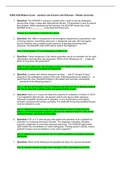Exam (elaborations)
NURS 6550 Midterm Exam
- Course
- NURS 6550 (NURS6550)
- Institution
- Walden University
1. Question: The AGACNP is caring for a patient who is quite ill and has developed, among other things, a large right sided pleural effusion. Thoracentesis is sent for pleural fluid analysis. While evaluating the fluid analysis, the AGACNP knows that a fluid identified as a(n) __________ is the lea...
[Show more]



